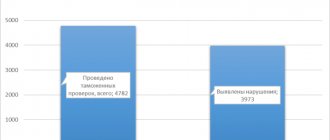What is advance notice?
Preliminary information (PI) is a procedure for providing information about goods and vehicles before their actual arrival in the customs territory of the Customs Union.
This event is intended to conduct a preliminary verification of certain information, as well as reduce the time for cargo clearance at the border. The main document establishing the rules for preliminary information is the Agreement between the Government of the Russian Federation, the Government of the Republic of Belarus and the Government of the Republic of Kazakhstan dated May 21, 2010 “On the submission and exchange of preliminary information on goods and vehicles moved across the customs border of the Customs Union.” Today, PI technology is regulated by the “Instruction on the specifics of customs officials performing certain customs operations in relation to goods and vehicles moved across the customs border of the Russian Federation, using preliminary information.” This instruction was put into effect by Order of the Federal Customs Service No. 1230 dated October 3, 2008.
It should be noted that the procedure for preliminary informing the customs authorities of the Customs Union has been introduced exclusively for goods imported (imported) into the single territory of the Customs Union. Depending on the type of transport crossing the border of the vehicle, there are several types of preliminary information:
- PI on goods imported into the territory of the Customs Union by road (mandatory from June 17, 2012, Decision of the Customs Union Commission No. 899 of December 9, 2011);
- PI on goods imported into the territory of the Customs Union by rail (mandatory from 10/01/2014, Decision of the EEC Board No. 196 dated 09/17/2013);
- PI on goods imported into the territory of the Customs Union by air (mandatory from 04/01/2017, Decision of the EEC Board No. 158 of 12/01/2015);
- PI on goods imported into the territory of the Customs Union by sea (mandatory from 10/01/2016 in the territory of the free port of Vladivostok, Federal Law No. 212-FZ of 07/13/2015).
Who compiles the EPI
The carrier or forwarder is forced to draw up notifications independently. Auto transport companies involved in international cargo transportation (with a staff of 30+ vehicles) employ a special employee who fills out notification forms. If there are fewer cars, many hire third-party declarants to draw up notifications. It costs less. There are more errors, but what to do? The solution is to draw up notifications about preliminary informing the customs authorities yourself. The main thing here is to understand the nuances. After all, let us remind you that the main thing is that the car is not parked at the border and that the cargo arrives on time.
The procedure for mandatory PI for goods imported into the territory of the Customs Union by road
This procedure was established by the CCC Decision No. 889 dated December 9, 2011 and came into effect on June 17, 2012. According to this document, authorized economic operators, carriers, including customs carriers, customs representatives (hereinafter referred to as Interested Parties) are required to submit preliminary information to the customs authorities regarding goods imported by road no later than 2 hours before their importation to the customs territory of the Customs Union.
Methods for submitting PI to customs authorities:
- website of the customs authorities of the Russian Federation customs.ru, in particular, the portal for electronic submission of information - edata.customs.ru. This portal provides the opportunity for participants in foreign trade activities to submit in electronic form preliminary information about imported goods and vehicles before crossing the customs border of the Customs Union on the basis of web technologies using the international association of Internet networks;
- portal of the customs authorities of the Republic of Kazakhstan - pi.customs.kz;
- in the Republic of Belarus, to submit information to the PI system, you need to use it, having previously concluded an agreement with this enterprise;
- You can also use specialized software to transmit PI information. For example, the software product “Alta-GTD PRO” developed - in addition to the tool for filing a declaration of goods, it contains the function of generating a PI document and sending it to the FCS database server and to the State Customs Committee of the Republic of Belarus for its subsequent use in accordance with technological regulations.
The PI scheme for importing goods by road is as follows:
Fig. No. 1. Scheme of the preliminary information process for goods imported by road
1
The transport company or the sender of the goods provides the Interested Person with information about the vehicle on which the goods will be delivered.
2
The interested person, having received information about the vehicle, fills out the PI document (TIR or transit declaration) and, through the FCS electronic submission portal, sends it to the FCS TsITTU server. Information must be submitted no later than 2 hours before their import into the customs territory of the Customs Union. The list of information transmitted as part of the PI document is defined in the CCC Decision No. 899 and depends on the type of customs procedure.
3
The server receives and processes the submitted information, and also carries out format-logical control (FLC) of the submitted information. In case of successful completion of the FLC, the interested person is given a unique identifier of preliminary information, which will need to be presented at the border checkpoint. The unique identifier of the PI submitted for the purposes of registration of arrival and opening of transit in accordance with national legislation is usually generated digitally and in the form of a barcode.
The customs authorities of the member states of the Customs Union, on whose territory the place of arrival of goods and vehicles is located, are required to analyze it using the risk management system (RMS) within 2 hours from the receipt of the PI.
4
The interested party, having received this identification number, prints out and transfers the PI document to the driver of the vehicle or reports the identification number to the dispatcher of the transport company, which prepares shipping documents. In the absence of preliminary information, the CCC Decision (clause 6) provides for interested parties the opportunity to submit the necessary information to the information system of the customs authorities within the next 2 hours. For these purposes, the Russian APP is equipped with workplaces where you can obtain a unique PI identification number about goods via the Internet and the portal of the Federal Customs Service of Russia and print it out.
5
Upon arrival of goods and vehicles into the customs territory of the Russian Federation, a document with a printed barcode is presented to the official of the customs authority located at the border checkpoint for the purpose of subsequent request for this PI number from the CITTU FCS database. In case of transportation of goods under the TIR procedure, the TIR Carnet number is used as a unique identifier.
6
By reading a barcode with a scanner in the standard customs clearance and customs control system, the official automatically generates a request to the database.
7
The CITTU FCS server automatically provides the information requested by the customs post. The preliminary information received in response to a request for a unique identifier is loaded into the standard software of the customs post at the checkpoint.
8
Next, the customs inspector carries out customs clearance and customs control in accordance with the established procedure, including comparing the preliminary information with the information contained in transport (transportation), commercial and (or) other documents. In the event of a discrepancy between the information contained in the preliminary information databases of the customs authorities of the CU member states and the information in the documents submitted by the carrier, the identified discrepancies are taken into account when deciding on the application of customs control forms in relation to the presented goods using the RMS.
A decision on the release of these goods in accordance with the customs procedure of customs transit is made no later than 2 hours from the moment of registration of the transit declaration, provided that there is no risk of non-compliance with the norms of the Customs Union legislation.
EPI: features
Electronic preliminary notification of customs authorities is a process of several stages.
- create an electronic copy of the TD (transit declaration),
- transfer TD to the automated system through special software,
- carry out format and logical control (to find errors),
- register the ETD
- receive a unique transportation identification number (UINP).
An electronic copy of the EPI is used as a copy of the transit declaration. The final stage is permission for customs transit.
LIST OF DOCUMENTS FOR GOODS AND VEHICLES REQUIRED FOR FORMATION OF EPI/PI
and preparing an electronic copy of the TD:
- CMR.
- Invoice.
- Driver's passport details, his mobile phone number.
- Information about the product (for each product item): - code according to the Commodity Nomenclature of Foreign Economic Activity, - description (in Russian), - net and gross weight or volume, - cost, - quantity, - packaging.
- Information about the vehicles on which the goods are transported: type, make, model, year of manufacture, VIN, registration plate, country of registration, registration certificate number (copies of registration certificates).
- Copies (scanned) of certificates of approval of international transport vehicles to transport goods under customs seals and stamps.
- Code of the place of delivery of the goods and name of the customs post (customs post) of destination.
- Number and expiration date of the TIR Carnet, identification number of the TIR Carnet holder (copy (scan) of the TIR Carnet), if transportation is carried out using a TIR Carnet, or a copy (scan) of the certificate of inclusion in the Register of Customs Carriers.
- Name of the import RPTO and the planned time of arrival of the vehicle at the border.
- Information about the quantity of goods in additional or specific units of measurement.
- Other documents, according to the fuel injection pump code of the goods being processed, that meet the requirements and norms of non-tariff regulation.
The cost of registration of EPI depends on the number of codes for each batch of goods.
The cost of the service for providing security for customs payments through the points of entry of the Republic of Belarus and the Russian Federation depends on:
- amounts of customs duties,
- distance to the customs office of destination.
For a preliminary calculation of remuneration for the provision of security across the territory of the EAEU from the customs authority of departure of the Republic of Belarus, the Russian Federation to the customs authority of destination of the EAEU, the following documents must be sent by mail:
- invoice,
- DEM,
- product code.
Regulatory documents on the presentation, use and registration of preliminary EPI information.
Currently, the Decisions of the Board of the Eurasian Economic Commission are in force, establishing the obligation, procedure and deadlines for submitting preliminary information in relation to goods intended for import into the customs territory of the Union by road, as well as the procedure for its registration and use, filling out:
- dated April 10, 2021 No. 52 “On the procedure for registering preliminary information about goods intended for import into the customs territory of the Eurasian Economic Union” (amending documents: Decision of the Board of the Eurasian Economic Commission dated July 31, 2021 No. 124, Decision of the Board of the Eurasian Economic Commission dated 20 October 2021 No. 129);
- dated April 17, 2021 No. 56 “On approval of the Procedure for submitting preliminary information on goods intended for import into the customs territory of the Eurasian Economic Union by road transport” (amending documents: Decision of the Board of the Eurasian Economic Commission dated July 31, 2021 No. 124, Decision of the Board of the Eurasian Economic Commission commission dated October 20, 2020 No. 128);
- dated December 25, 2021 No. 214 “On the use of preliminary information presented in the form of an electronic document” (amending document: Decision of the Board of the Eurasian Economic Commission dated October 20, 2021 No. 129);
- Decision of the Customs Union Commission dated June 18, 2010 N 289 “On the form and procedure for filling out the transit declaration”;
- Decision of the Customs Union No. 438 dated August 17, 2010 “On the procedure for customs authorities to carry out customs operations related to the filing, registration of a transit declaration and completion of the customs procedure of customs transit.”
Product description
The correct description for the correct HS code is very important, because if this description turns out to be insufficiently informative (if there is a correctly selected code), the customs authorities will not clear the goods until you present the product description.
A product description is understood as a special document with a detailed description of the type of goods, with the necessary signatures and seals, as well as with all accompanying documents, which include TIR books, CMR, invoices, etc. It takes a lot of time to compile such a document. That is why drawing up an EPI requires especially careful preparation with clarification of all possible details. You can find out all the nuances by referring not only to the code description, but also to the information provided by the product manufacturer on the Internet and other resources.
In those rare cases when the cargo is exclusive, you can contact the recipient or sender directly for the necessary information.
Partial delivery of goods also has its own design features, which you can clarify in the Order of the State Customs Committee of the Republic of Belarus dated December 16, 2011.
Of course, it is worth remembering about such categories of cargo as its weight, cost, total volume of space it occupies: the HS code has a corresponding gross weight, total cost and area of the cargo. The total amount must agree with the data in the TIR and CMR.
ALGORITHM FOR PROVIDING EPI SERVICES
(from the customs authority of departure of the Republic of Belarus, the Russian Federation to the customs authority of destination of the EAEU):
- Contact the commercial department (e-mail or phone: +375 29 694 00 76 or skype: [email protected] ) to conclude an agreement for the provision of customs representative services.
- Send documents for registration in scanned form or photos of documents by e-mail:
- Receive transportation UINP number by email. mail and sms message with transportation UINP number to the driver’s number specified in the application, and a transit declaration in two copies on paper at the locations of our partners.
- Go through all types of state control at the RPTO, enter the vehicle number or UINP number of transportation into the AS “Monitoring” system and, according to the queue, proceed to customs clearance.
- The customs officer will check the EPI with the submitted documents, and if there are no discrepancies and inaccuracies in the documents provided by the carrier and the information in the EPI, he will release the goods.
Correct preparation of EPI
What do you need to remember when applying for an EPI? As mentioned earlier, this is a painstaking work in which it is necessary to take into account all the characteristics of the cargo, using data from invoices, packaging and CMR.
In order to avoid unnecessary questions when registering cargo at customs, it is worth checking in advance with the sender or recipient the following items: code - gross weight - occupied area (volume) - cost. Then the description of the codes can be at least relatively accurate. You can see an example of fairly organized detailing in the table below.
Separately, it is worth noting such an item as the amount of space occupied by the cargo. The volume is indicated in the shipping documents, and the number of places is indicated at the time of registration of the goods in the shooting gallery. Once the data has been recorded, no changes or additions can be made.
The last point of this article is one more addition - be careful about the indicated and calculated invoice currency. In order not to redo the EPI, check that the recipient and sender are the same as in the CMR and invoices.
Guarantee service before the customs authorities of the Republic of Belarus (security certificate).
When imported into the territory of the EAEU for delivery to the customs authority of destination, foreign goods are placed under the customs transit procedure. At the same time, providing security for the payment of customs taxes and duties is an important condition. A surety is one of the ways of securing.
IP "SGS Minsk" LLC offers the service of providing a certificate of security for payment of customs duties and taxes
To issue a certificate, we need the following documents/information:
Xml file EPI
Advantages of using the guarantee of IP "SGS Minsk" LLC:
— unlimited guarantee amount;
— provision of services around the clock, without weekends and holidays.
The cost of the service depends on:
— amounts of security for payment of customs duties and taxes;
— transportation range.







